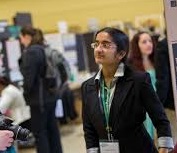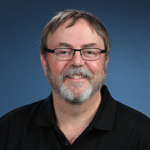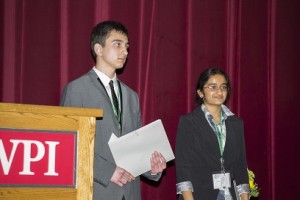Two students from Mass Academy of Math and Science at WPI have made it to the final round of what’s considered the Super Bowl of science fairs: the Intel Science Talent Search (Intel STS). Amol Punjabi and Yashaswini Makaram, both of Northborough, are the only students from Massachusetts among the 40 finalists. The students will attend the finals in Washington, D.C., March 10–16, with winners announced at a black-tie gala on March 15.
“No matter what happens, to be named a finalist is such a great honor and such a great recognition of their work,” says Mass Academy director Michael Barney. “It’s a significant experience [for them] just to share their research with the people on this level.”
“To be recognized at this level, your research has to be outstanding and you also have to be a great writer, because the judges look at how you present your research,” he adds, noting that Mass Academy emphasizes research, writing, and oral presentation skills in its program.
Five Mass Academy students made it to the semi-finals; Punjabi and Makaram advanced to the main event. While in Washington, the students will participate in final judging, display their work to the public, meet with notable scientists, and compete for awards, including three top awards of $150,000.
“No matter what happens, to be named a finalist is such a great honor and such a great recognition of their work.” – Mass Academy director Michael Barney
Makaram developed a biometric cell phone security technique for her computer science project. She wrote an app to measure the unique arm and hand motions an individual uses to lift a cell phone from a table by capturing the accelerometer and gyroscope sensor data generated by each person. She then instructed pseudo-attackers, guided by videos, to attempt to copy the phone-lifting motion of the authentic user, which in most cases they could not. In this latest phase of a two-year project, she fine-tuned her data analysis so that failed attempts to impersonate the phone’s owner further improved the cellphone’s security performance, correctly identifying the owner 85 percent of the time and differentiating among people with 93 percent accuracy.

Yashaswini Makaram
A senior who has been accepted at MIT, Makaram has been competing in science fairs since middle school, but says the resources and support she has had from Mass Academy are unsurpassed.
“Mass Academy structures the process really well,” she says, offering everything from a checklist to the resources available at WPI, to brainstorming and sharing ideas with fellow students.
She says she’s most looking forward to meeting the science experts at the events and also discussing the projects with the other finalists.
“I think this competition is a good way to get a broader perspective on what I’m researching. It gives us a chance not just to focus on our own projects, but also ask others questions–and have them ask me questions. It’s good way to help me learn about other areas of science I might be interested in,” she says.
Punjabi is also eager to meet his fellow finalists.

Mike Barney
“Just reading over the bios in finalist book—everyone is so impressive. So, I’m looking forward to getting to know these kids. I’m sure down the road they will be colleagues and collaborators. There are working on a lot of cool problems I’d like to tackle, and I can learn from them,” he says.
A senior who has been accepted at Harvard University, Punjabi submitted a computational biology and bioinformatics project for the Intel STS that sought to more accurately predict targets for designer drug development. He created classification software, ViaPocket, to search for ordered areas of IDPs, or intrinsically disordered proteins. IDPs appear in most cancer and cardiovascular disease pathways, but are challenging to target with designer drug molecules because they lack a fixed three-dimensional structure into which those molecules can fit. Despite this characteristic, IDPs retain regions of recognizable features in their protein chains. Punjabi hypothesized that he would find ordered, targetable areas near those regions. He showed that ViaPocket was more accurate than current predictors and then located six previously unknown potential binding sites.
EACH FINALIST RECEIVES A $7,500 PRIZE
The 21 young women and 19 young men chosen as finalists come from 38 schools in 18 states. Finalists were selected from among 1,750 entrants representing 512 high schools in 43 states, Washington, D.C., Puerto Rico, and six overseas schools, according to the Intel STS finalist book. In addition to an all-expenses-paid trip to the nation’s capital, each finalist received a $7,500 prize.
Perhaps the biggest prize of all is just to have the finalist designation on their resumes, where it will give them a leg up when applying for internships, graduate schools, and jobs, says Barney.
“When someone sees they are an Intel finalist, it shows they already know how to do research on the forefront of technology. They’re knowledgeable, they’re exemplary students, they’re a cut above. These are the types of young adults that people want to bring onto a team, into a company or a program, and that other researchers want to collaborate with,” he says.
Collaboration pays big benefits out in the field, which is why Mass Academy—like WPI—supports group projects and teamwork, says Barney. Even while vying for top spots in a prestigious competition like this one, the students helped and encouraged each other through peer reviews, presentation feedback, and team support.
“What’s great about all these students is that they are so happy when the other students succeed,” he says, noting that Punjabi’s first concern, after hearing he was a finalist, was whether his peers had made it, too. “It’s a collaborative environment we build here—as a director that makes me proud.”
He’s also proud of the students’ work, now and what they’ll do in the future.
“From the state and national standpoint, this is why we talk about how important it is to support STEM education. The research Amol and Yashaswini are doing and the research they will continue to do will contribute to society—from how drugs will be developed to cure diseases to phone security, and other ways technology can be improved,” he says. “Our future is in their hands.”
– BY CATE PRATO

